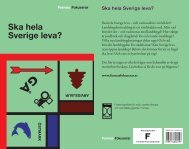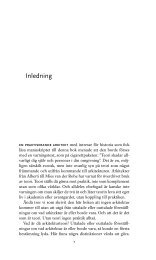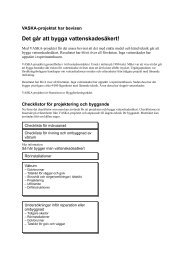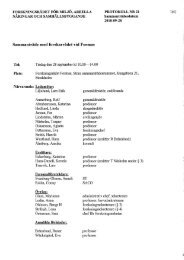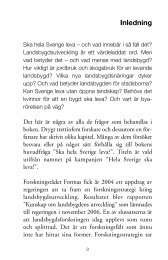Ladda ned - Formas
Ladda ned - Formas
Ladda ned - Formas
You also want an ePaper? Increase the reach of your titles
YUMPU automatically turns print PDFs into web optimized ePapers that Google loves.
unscathed by the wrath of HIV/AIDS 4 . As of<br />
2003 there were 42 million people living with<br />
the HIV virus and 29 million of these were in<br />
the African continent. The nature of the disease<br />
in Africa has been most devastating affecting the<br />
most skilled and most educated leaving gaping holes<br />
in the skilled labour force, and agricultural and<br />
health sectors have not been spared 5 . The continuing<br />
discovery of highly active antiretroviral therapy<br />
(HAART) medication in managing HIV/<br />
AIDS has brought revived hope in the highly affected<br />
countries in Sub-Saharan Africa. Where as<br />
in the past decade the exodus for brain drain has<br />
been mostly economic the new wave is in search<br />
of economic remittances and access to HIV/AIDS<br />
treatment 6 . Furthermore this new exodus has on<br />
average a lower education attainment than the average<br />
person in the recipient source country. The<br />
high cost, social stigma and discrimination associated<br />
with HIV/AIDS especially in Asia and<br />
Africa makes it more “attractive” to migrate to<br />
the Northern countries, Sweden no exception, for<br />
this treatment. The cost of delivering HAART in<br />
poor countries is compounded by the loss of skilled<br />
health professionals moving (for economic gains)<br />
into the health sectors of developed countries to<br />
provide care for the aging populations 7 .<br />
The migrant’s health<br />
The link between employment and health<br />
Unemployment statistics show that the employment<br />
situation of migrants in Sweden has worse<strong>ned</strong><br />
during the past decades and that this is largely<br />
due to structural reasons 8 . A recent study further<br />
shows that migrants in particular non-European<br />
migrants have considerably higher unemployment<br />
rates and lower wage incomes than native Swedes<br />
and the main reasons cited for this are 1) structural,<br />
2) network effects (due to separated ethnically homogenous<br />
networks) and 3) statistical stereotypical<br />
thinking 9 . Many studies also show that there is a<br />
clear link between unemployment, poor economic<br />
resources, low education level also known as socio-economic<br />
status (SES) and health 10 . Migrants<br />
from outside Western Europe and belonging to<br />
socially disadvantaged groups, also with the higher<br />
unemployment rates, tend to exhibit more poor<br />
health than their counterparts 11 . Why is this important<br />
and should we as health practitioners be concer<strong>ned</strong><br />
about this. The answer is obviously yes. Food<br />
and health are closely inter-related. An individual<br />
that is excluded from society psychologically does<br />
not feel well 12 , and will more often than not react by<br />
either consuming too little (anorexia) or too much<br />
food (overweight) 13 , and in some cases, will seek<br />
more health care and consume more anti-depressive<br />
drugs 14 as a coping or struggling mechanism.<br />
78<br />
The migrants’ food – a question of<br />
identity<br />
With people migrating constantly in search of a<br />
better quality of life, it is inevitable that food habits<br />
also migrate, together with the foods required<br />
to sustain food habits and identity. Food from<br />
”home” is one of the things that you most miss<br />
and look forward to when living abroad 15 . “Tell me<br />
what you eat and I will tell you what you are” as the<br />
saying goes. So what do you see when you see an<br />
“Afro-Swede” eating pancakes and pea soup? Food<br />
and culture are two very inseparable factors when<br />
it comes to migrant acculturation.<br />
The migration of food to countries in the north<br />
has come about as a result of colonialism, migration<br />
or tourism. Food brings about a strong identity<br />
to one’s own culture that makes one similar<br />
or vastly different from another. Migrants in any<br />
situation attempt to maintain their culture, however<br />
culture is not static. There are mechanisms to<br />
adapt and change that which must absolutely be<br />
changed for example food habits. Acculturation<br />
refers to the process by which groups and individuals<br />
adapt to the norms and values of an alien<br />
culture 16 . Although the process is assumed to be a<br />
two-way process this is usually dominated by one<br />
culture, the host culture.<br />
Customarily, the migrant is a mobile person<br />
looking for hospitality. The word hospitality refers<br />
to a metaphor for encountering the stranger with<br />
warmth. Paradoxically embedded in the spirit of<br />
hospitality is the aspect of hostility. This is made<br />
apparent when asylum seekers or certain migrant<br />
groups are seen as “utilising” the system or as parasites<br />
especially when they receive subsidies. This<br />
perception not only makes the stranger “uneasy”<br />
but it may also force the stranger to be bipalatal,<br />
eating local food in public and “own cuisine” behind<br />
closed doors at home. This bipalatalism also<br />
affects beliefs, attitudes and particularly the social<br />
use of foods 26 . The older an individual is when they<br />
migrate the more resistant they may be to change<br />
(see Pudaric et al.,) and the less integrated they<br />
may be (see Albin et al.,). While it is assumed that<br />
the younger people may rapidly adopt the new culture<br />
and food habits general studies on health and<br />
well-being show that there is an over-representation<br />
of school drop-outs as well as over-representation<br />
of academic well-achievers 17 . Second-generation<br />
immigrants in Sweden tend to have their own<br />
distinct health and disease pattern that we know<br />
very little about 18 . We know even less about how<br />
this is linked to their diet and lifestyle an interrelationship<br />
is worthy of elucidating.<br />
Acculturation is not without problems, especially<br />
when it comes to food habits. Studies in<br />
North America have shown how “eating the white




